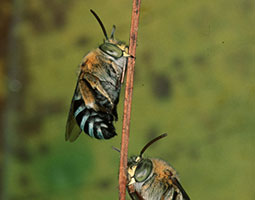Amegilla cingulata
Description

Bluebanded Bees are solitary bees with a golden thorax and iridescent blue or white stripes on a glossy black abdomen. The bee has a long tongue to suck the nectar from flowers.
After mating the female builds a solitary shallow burrow in the dirt, sometimes neighbouring another Blue-banded female. Females use their jaws to dig burrows in which they create oval shaped cells, lining them with waterproof secretions. Before depositing the egg, a mixture of nectar and pollen is placed in the cell. Once all cells are filled and capped the burrow is closed with a layer of soil. The female then goes in search of another nesting site.
Male Blue-banded Bees roost together in small groups at night, hanging onto twigs with their mandibles.
Adaptations
- The hairy bodies of bees allow them to effectively remove pollen from flowers and carry it back to their nests
- Special brushes on their legs help groom the pollen from their body to their mouths
- Bees have large compound eyes (multi-lens) and three ocelli (single lens eye) which gives them excellent vision
Feeding relationships
- What I eat: pollen
- What eats me: predatory insects such as dragonflies, robber flies, assassin bugs as well as spiders and birds
Interesting facts
Blue-banded Bees are one of a few native bees that pollinate via buzz pollination or sonification when the bee grabs onto the flower and shakes its body rapidly which dislodges the pollen from the anther. This process is not performed by the introduced western honey bee, and thus the Blue-banded bee is particularly useful for pollinating crops such as tomatoes, blueberries and eggplants.